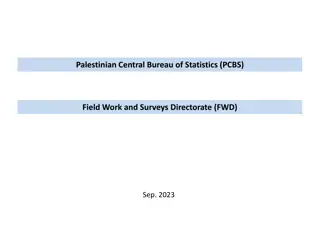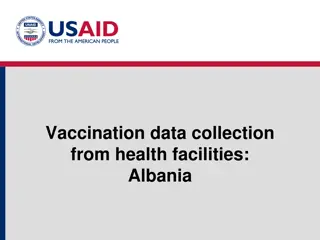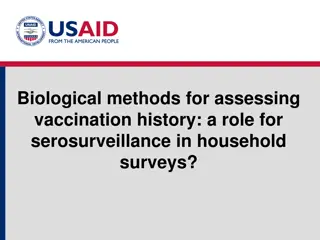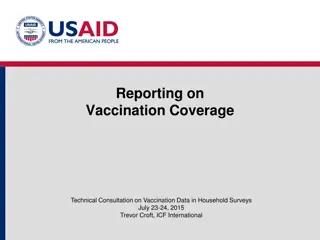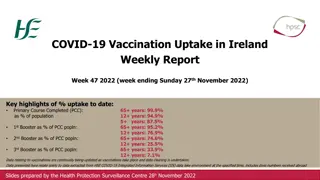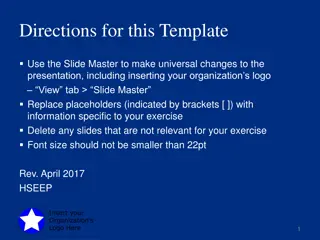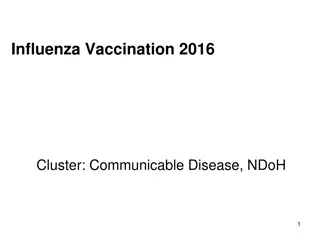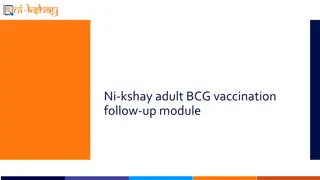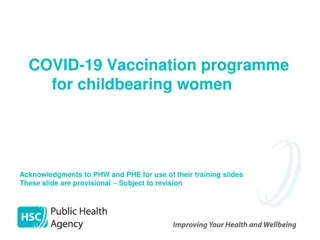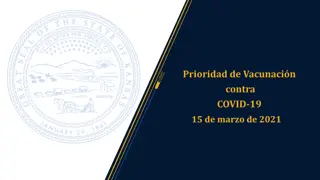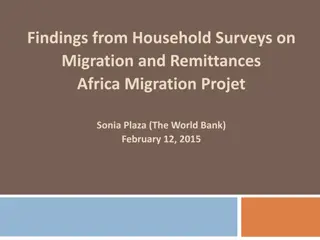Exploring Data Quality in Household Surveys and Vaccination Coverage Discrepancies
This study delves into issues of data quality in household surveys, particularly focusing on vaccination coverage across different survey forms. It discusses the sources of information on infant immunization coverage, the utilization of survey results in evaluating program coverage levels, and the discrepancies observed across various surveys due to differences in sampling schemes, questionnaire formats, and implementation processes. The importance of accurate data in estimating national immunization coverage is highlighted, along with the role of such surveys in grant monitoring frameworks.
Download Presentation

Please find below an Image/Link to download the presentation.
The content on the website is provided AS IS for your information and personal use only. It may not be sold, licensed, or shared on other websites without obtaining consent from the author. Download presentation by click this link. If you encounter any issues during the download, it is possible that the publisher has removed the file from their server.
E N D
Presentation Transcript
Exploring issues of data quality in household surveys: Exploring issues of data quality in household surveys: Searching for explanations behind discrepant results for Searching for explanations behind discrepant results for vaccination coverage across surveys of different form vaccination coverage across surveys of different form Technical Consultation on Vaccination Data in Household Surveys 23-24 July 2015 ICF International, Rockville, Maryland USA
Background Background Population-based household surveys are a common source of information on infant immunization coverage data beyond administrative recording and monitoring systems Three main household survey sources Expanded Programme on Immunization (EPI) cluster survey UNICEF-supported Multiple Indicators Cluster Survey (MICS) USAID-supported Demographic and Health Survey (DHS) Within these surveys, vaccination history is determined by documented evidence within home-based records (HBRs) asking the child s caregiver (recall) or through the combination of both sources some surveys may also include a facility trace back component wherein facility-based records are reviewed for documented evidence of vaccination history
Background Background Some countries utilize the estimated coverage results from population-based household surveys when evaluating programme coverage levels, particularly if there are known problems with administrative coverage reports (e.g., systematic under-/over- reporting, missed sub-populations) WHO and UNICEF utilize the estimated coverage results from population-based household surveys when producing estimates of national immunization coverage for each of 195 countries Secretariat for Gavi, the Vaccine Alliance using coverage surveys as one of several data quality requirements in their grant monitoring framework
Across surveys, differences abound Across surveys, differences abound Primary objectives Sampling schemes Levels of oversight Questionnaire format, content, verbal prompts for vax Hx, etc Often, implementing agency differs Data cleaning, analysis, reporting Many other differences as one goes further into the operations and implementation See Cutts et al, PLOS Medicine 2013
What is the most likely scenario ? What is the most likely scenario ? EPI CLUSTER EPI CLUSTER EPI CLUSTER DHS/MICS DHS/MICS DHS/MICS
Observed differences across survey types Observed differences across survey types > documented evidence > documented evidence median/mean home-based record ownership levels observed among children aged 12-23 months at the time of survey by survey type across 199 population-based, nationally representative surveys that estimated coverage for birth cohorts between 2005 and 2012 100 80 HBR, mean (s.e.) HBR, median (IQR) EPI 74% (18.3) 77% (25) 60 DHS/MICS 62% (22.7) 67% (38) HBR OCS 56% (24.6) 57% (37) 40 20 n=56 n=34 n=109 0 DHS/MICS EPI OCS
Observed differences across survey types Observed differences across survey types > documented evidence > documented evidence Relative frequency of home-based record ownership levels observed among children aged 12-23 months at the time of survey by survey type across 199 population-based, nationally representative surveys that estimated coverage for birth cohorts between 2005 and 2012
Observed HBR ownership levels from above Observed HBR ownership levels from above country example country example Survey Observed HBR ownership for children 12-23 m (%) DHS, 1999 birth cohort 27 (survey sample, n=2143 12-23 m old children) 2004 birth cohort 37 (survey sample, n=1877 ) 2010 birth cohort 29 (survey sample, n=1927 ) EPI cluster, 2000 birth cohort 52 (survey sample, n=3564 ) 2005 birth cohort 60 (survey sample, n=6903 ) 2011 birth cohort 37 (survey sample, n=3762 )
Reasons for observed differences in HBR ? Reasons for observed differences in HBR ? Perhaps related to Perhaps related to Differences in sampling frame or field procedures in HH selection across survey types Differences in survey field team training Differences in implementation of time allowed for caregiver to fetch HBR Others to be discussed
Additional example slides Additional example slides
Challenges Challenges Scenario: 2 surveys estimating coverage for the same birth cohort EPI cluster survey with sample of 3000+ children aged 12-23 m and observed HBR prevalence of 83% estimates DTCV3 (HBR+recall)=85% Pol3 (HBR+recall)=85% DHS with sample of 935 children aged 12-23 m and observed HBR prevalence of 75% estimates DTPCV3 (HBR+recall)=75% ; adjusted for recall bias=80% Pol3 (HBR+recall)=42% Both estimates for polio cannot be correct.
Challenges Challenges Scenario: 2 surveys estimating coverage for the same birth cohort EPI cluster survey with sample of 3000+ children aged 12-23 m and observed HBR prevalence of 80%, estimates DTCV3 (HBR+recall)=70% Pol3 (HBR+recall)=68% DHS with sample of 1200 children aged 12-23 m and observed HBR prevalence of 60%, estimates DTPCV3 (HBR+recall)=72% Pol3 (HBR+recall)=90% Again, both estimates for polio cannot be correct, but in this case it is likely that the estimated level from the DHS reflects doses given during campaigns given frequent polio SIAs in the country and reliance on recall for 40% Challenge mechanisms for isolating routine vs SIA vaccination
I: ignore surveys II: all surveys III: household surveys IV: national EPI surveys



